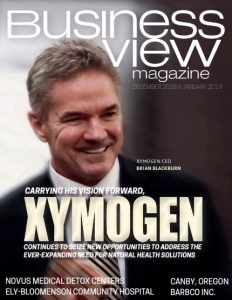Sanford, North Carolina
Leveraging its assets
Business View Magazine interviews representatives from Sanford, North Carolina, as part of our series on best practices in American cities.
Sanford, North Carolina, located in the central Piedmont area of the state, is a city of approximately 30,000, and the county seat of Lee County. It began life as the state’s western frontier, home to Native American hunters and farmers, with settlers pushing into the region decades before the American Revolution – migrating colonists from Pennsylvania, Maryland, Virginia, and coastal regions of North Carolina, as well as Scottish immigrants arriving in America. The city was incorporated in 1874, and named after C.O. Sanford, a railroad engineer who was instrumental in the building of the rail lines through the area.
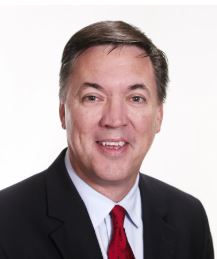
Chet Mann
Mayor
Because Sanford, North Carolina sits where white beach sand from the coast meets the Piedmont clay, the city has the right ingredients to be a large producer of clay bricks. In fact, at one time, Sanford produced almost 10 percent of the bricks in the United States and was named “Brick Capital of the USA.” Other industries which contributed to the city’s economy included textiles, furniture, and tobacco, all of which began suffering a severe decline in the 1990s – a decline that was further exacerbated by the Great Recession of the early 2000s. Lately, though, Sanford, North Carolina has made a significant comeback, redefining its character and charting its growth for the future.
“We put an agenda out there; we had a vision and that vision was the continual leveraging of our assets,” says Sanford Mayor, Chet Mann, who was first elected in 2013 with an “Open for Business” platform, focused on job creation, quality of place, community pride, and establishing Sanford as a destination location. “One of the things that we’ve done is that we have taken our biggest asset which is water and wastewater capacity,” he continues. “We probably have more capacity than anyone in our region and we have entered into two interlocal agreements with the City of Pittsboro and the County of Chatham. The Chatham County interlocal agreement will allow us to provide wastewater service to the new Moncure Megasite (a 2,500+ acre industrial property, located in the Research Triangle region of North Carolina).”
“In that agreement, we will share their property tax revenue for the next 50 years.” Mann adds. “They actually have two megasites in Chatham County; they could not afford the millions that it takes for both, so they needed to do an equal distribution for both megasites. So, we were able to come in and provide the wastewater capacity and a $12 million wastewater line. That was a great collaboration because it provided the needed the component for Chatham County to bring in jobs. And we’ll be a partner.” In addition, the City has its own pieces of industrial parkland that are available should an OEM, such as a large automobile manufacture decide to locate at the Moncure Megasite. “If that OEM hits, we’ll have plenty of prime spots below market rate to attract that big industrial user and its suppliers. That would be a game changer.”
“We did something similar in Pittsboro,” Mann continues.”There’s a development called Chatham Park that’s going to be the third largest planned neighborhood in the United States. Pittsboro’s got about 4,000 people and simply did not have the water or wastewater capacity. They’re going to need to provide 60,000 people over the next 20 years. We were able to do that. We signed an interlocal agreement with the Town of Pittsboro to provide two million gallons a day of wastewater capacity; their plant currently has a 750,000 capacity and they were already two thirds full to that.
“So, in leveraging those assets, we receive a return on investment and kind of create this regional collaboration that’s been important, going forward. Over time, it’s going to be a great partnership for both of us in both those areas and will keep us viable in the state as more and more regional collaboration happens. It’s easier to get grants; it’s easier to get federal and state funds when you’re working collaboratively and not stopping at the county line. That’s how cities our size are going to have to do things in order to be viable. You’ve got to leverage your assets, share them, and use them to grow.”
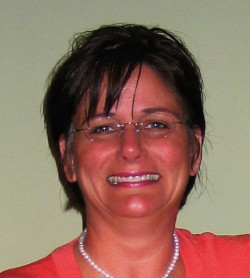
Liz Whitmore
“Another thing we’re working on are Opportunity Zones,” Mann continues. “It’s an interesting concept. The President wanted us to look at blighted areas across the country and said to the governors of all 50 states, ‘Go to each county, and under a certain set of criteria, identify your Opportunity Zones.’ So, we submitted four blighted areas in Sanford, North Carolina that we’d like to see improve, and the State took one.
“An Opportunity Zone will allow you, as a developer, to offset your capital gains on a former project by investing them into an Opportunity Zone. So, if you made a million dollars on a project in downtown Raleigh, and you wanted to invest your money in an Opportunity Zone in Sanford, North Carolina, you can defer your taxes on the gains you made on the project in Raleigh. You can come in and invest in any one of 300 parcels that could be improved. We’re looking at a blighted area in our town that abuts our downtown, and we’ve got a plan to turn that area into a village and using the Opportunity Zone as an inducement to bring people from outside town or out of state and say, ‘Take ten or twenty of these properties, mix in commercial/retail, whatever you want to do, as long as you build to a certain standard our planning department created, and you can offset your gains, and potentially, make even more money, long term.
“We’re going to try and attract big and small developers that want to come in. We’re even considering offering some lots for free, as long as you consider doing something under the village concept that we have. If you buy five of these properties, we may even give you one of ours, as long as you propose a plan that will work. We have some beautiful hundred, hundred-twenty-year-old homes that just need some love. Some need to be brought to the ground; some just need to be improved.
“We have an industrial plant that makes pool products – a Fortune 500 company – and their backyard is in the Opportunity Zone. So, they can defer taxes on a project that they had somewhere else in the United States, and expand their plant if they want to. So we’re using it, not just for residential, but for commercial and industrial use, as well.
“The Opportunity Zone concept is pretty new and most investors are still learning about it and sometimes the government is slow to tell you all the rules and all the IRS ramifications. As soon as that becomes a little clearer, we’re going to market through our Economic Development organization and put it out there.”
Another part of Mann’s agenda when he came into office was making Sanford, North Carolina more of a destination attraction. “And one of the things we needed to do was enhance our cultural arts,” he explains. We’ve always had pottery; Temple Theater is one of the best Vaudeville style theaters in the country; but we never really worked on an initiative or celebrated that in any kind of formal way. So, we set out to create a public arts initiative.”
That initiative is the purview of Liz Whitmore, a member of the City’s Planning and Development Department and the liaison for the program. A major part of the Initiative is the creation of a dozen historical murals in downtown locations, depicting important scenes from Sanford’s past. “We have 11 murals up, as of today,” Whitmore reports. “$150,000 was privately donated money from citizens and businesses, and we received a grant from the State of North Carolina for $40,000. The City chose to match that grant money, so that gave us an extra $80,000 that we are in the process of spending.”
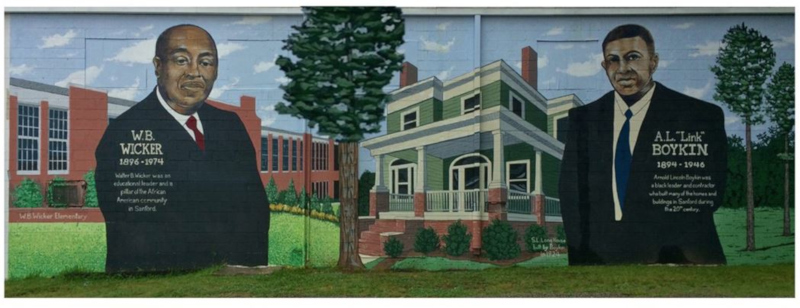
Visionary Builders
“All our murals recognize an event, or people, or a business that is no longer in existence,” Whitmore explains. “Our first mural was the Sanford Spinners, which was a minor league ball team here in the early 1940s; they were the Tobacco Road Champions three years in a row. Crash Davis (whose name inspired the character from the movie, Bull Durham) played for them for one season. Our second mural was Herb Thomas and his Fabulous Hudson Hornet; he was instrumental in starting NASCAR and Hudson, the car in the movie, CARS, is modeled after his Hudson Hornet. We have Silent Wings for three glider pilots that flew during World War II, who were born and raised here in Sanford, North Carolina and made it back alive. We’ve also recognized two African-American pillars of the community – one was an educator, W.B. Wicker, and the other one was Link Boykin, who in the early 1900s had a brick mason business that, at one time, employed up to 100 brick masons. The Fairview Dairy mural is the first three dimensional mural in North Carolina; the mural is 50 feet tall and about 60 feet long. It’s actually on the building where the Fairview Dairy was, originally, although it’s no longer in existence. But the people that ran it are still here in the area. We are in the process of doing another mural that recognizes all the art in Sanford, North Carolina. It’s a ten-foot diameter wheel that you can spin. We’re pretty excited about that one.”
The City is also getting several “ghost signs” redone. A ghost sign is an old, hand-painted advertising sign that has been preserved on a building for an extended period of time. “Coca-Cola paid to have all of our Coke ghost signs redone – there were four of them, downtown,” says Whitmore. “We’re also having the Sanford Business College sign redone.”
Another part of the Public Arts Initiative celebrates the City’s iconic train engine No. 12. “We had 13 little bronze trains made that are going to permanently installed throughout downtown,” Whitmore notes. “We developed a scavenger hunt/discovery trail for people to find them. When they do, they have a little passport book they get stamped and they get an engineer’s cap. We also have an ‘Art on Fire’ program, which is 18 fire hydrants downtown, where we have had high school students submit artwork so that they could paint the fire hydrants. We provided the paint, and we’ve got half of those done.”
“Once everything is completed, we’ll have about $240,000 worth of public art in the City of Sanford, with a population of just 30,000 people,” Whitmore states. “It was important for us to keep our history alive for our young people because people forget. We also see it as an economic engine; we’ve had a $9.5 million streetscape improvement project downtown and with the mural project, we’ve had a lot of business owners invest in their properties or spruce up their exterior facades. So, our goal is to make our town an arts destination and I think we’re on our way to make that happen.”
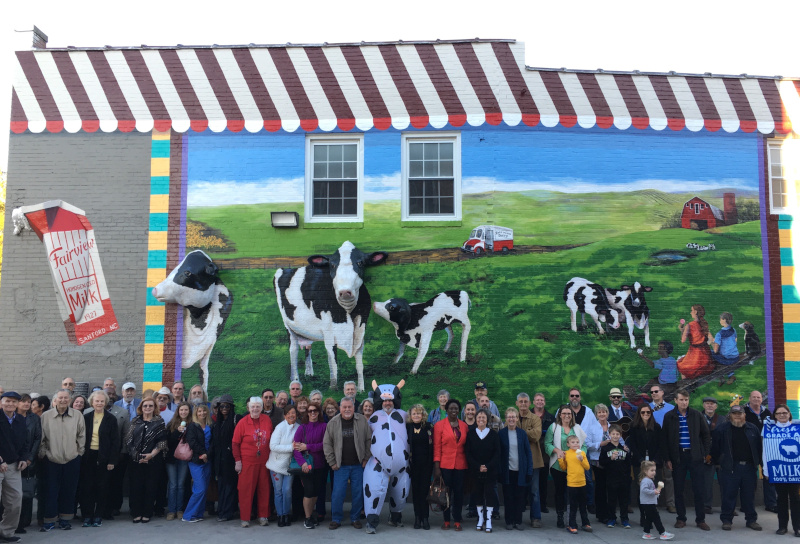
Fairview Dairy Dedication
“Liz has done a super job of finding the privately-owned building owners who have wanted to come in and work with us. The building owners allow murals to be placed on their walls and they have been financed by business owners, families, citizen donations, non-profits and others,” Mann exclaims. “So, we’ve got the private and the public sectors working together on this, and now, we’ve got a line of people who want to do more. So, we’ve really engaged our community; they’re buying into the organization and now they’re putting in their own money to beautify their own walls with these beautiful, historical murals. We’re a 140-year-old railroad town, and it’s really unlocked our heritage and our history for others to enjoy. It’s created a lot of pride in our citizens. It’s been a great way of connecting people to their city.”
“We’re starting to notice that people are coming from other cities to see what we’re doing and others are coming to spend the day with us,” Mann says in conclusion. “That has been a nice component of our economic development story – bringing our downtown alive through public art. And it’s opened up the creative flow of our citizens, who all seem to love it. We’re real proud of it; it’s changed our downtown ‘vibe’ and it makes people want to consider living in Sanford.”
Check out this handpicked feature on Sustainable CT – Local actions – statewide impact.
AT A GLANCE
WHO: Sanford, North Carolina
WHAT: A city of 30,000
WHERE: Lee County, North Carolina, approx. 42 miles southwest of Raleigh
WEBSITE: www.sanfordnc.net

